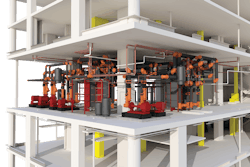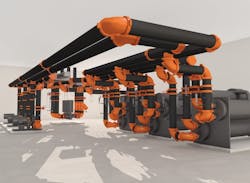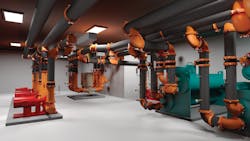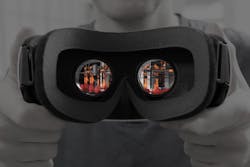BIM at 30: Benefits Still Growing, Exponentially
As we approach fall 2021, some 18 months since the start of the COVID-19 pandemic, the future looks bright in the construction industry, especially for investments in both infrastructure and urban projects.
In the spring of 2020, analyst projections adjusted for the realities of operating and planning for projects during a pandemic. McKinsey & Company noted, “The coronavirus pandemic has forced construction companies to adopt new and readily available technologies, and that adoption will continue in the short term and post-pandemic.”
As time has progressed, those same analysts have now predicted increases in tech investments, use of digitization and modular construction.
When building information modeling (BIM) was introduced in the 1990s, many companies in the architecture, engineering and construction (AEC) industry were enticed by the immediate benefits of adopting a centralized and streamlined approach to project management. Now, 30 years later, those early adopters continue to explore how technological advancements can further aide in their BIM journey.
Incorporating advanced software like Autodesk’s REVIT, BIM COLLABORATE, Recap, and Navisworks into a project’s lifecycle enables designers to continually re-examine what is possible using virtual modeling technology. While BIM has always championed integrated workflows to support better communication, software companies like Autodesk have recognized interoperability as the key to driving that communication forward. The launch of its Construction Cloud platform illustrates that point – its lifecycle software supports AEC industry projects from cradle to grave and allows companies to work more effectively and efficiently than ever before.
BIM has been a solution of choice in heating, ventilating and air conditioning (HVAC) projects for some time. Inspired by the successes of companies using BIM in other sectors, forward-leaning HVAC companies began experimenting with BIM with the hope of achieving similar results. These first movers quickly saw that embracing BIM technology gave them a competitive advantage, allowing them to work faster and smarter.
Calculating the Advantages
Leveraging BIM enables fast-tracking of the design process. And using tools like Revit makes it easy to visualize and conceptualize mechanical, electrical and plumbing (MEP) systems, identify potential problems, and work collectively to find solutions, thereby spending less time correcting changes. Collaborating on the front end also minimizes the likelihood that costly design changes will have to be made on the jobsite.
Revit also enables the use of third-party tools, such as the customized Victaulic Tools for Revit® (VTFR), which allows MEP engineers to reduce requests for information (RFIs) and better define design intent when building out mechanical rooms or customizing assemblies specific to the project at hand. This improves design accuracy and simplifies the construction process by allowing parts to be spooled directly from the approved design, amplifying Revit’s functionality, while providing time-saving tools for pipe routing and editing of the piping system design.
Tools like VTFR offer an easy way to rotate components such as valves and fittings or to complete pipe runs at specified angles. Users also can create fabrication documents, resize pipe, or change fitting and accessory sizes with the click of a button.
Tagging features also make coordination, placement, and installation more efficient by allowing designers to organize prefabricated assemblies and apply preset tags sequenced to their project build strategy. So, questions such as “where” and “in what order” to install systems are addressed before the prefabricated materials arrive on site. This capability cuts down the number of hours required for installation and reduces costs.
BIM-enabling tools improve project management and execution, making it possible to avoid costly delays associated with design and coordination issues. By utilizing BIM, project managers can instantly identify clashes, create routing alternatives, run cost reports, and update current fabrication documents directly in the fabrication shop using connected workflows.
Cloud-based file storage is another plus. Programs like BIM COLLABORATE let teams share documents and collaborate globally from any location, tracking project issues in real time so project stakeholders can view changes and understand why modifications were made.
Technology advances are also being incorporated in today’s BIM offerings. The introduction of virtual reality (VR) is one example. Today, models can be pulled directly out of 3D modeling software like Autodesk Revit and placed into a virtual environment by using Revizto, which enables teams to “enter” the design space and walk through the model using VR gear.
This lets them see how equipment is positioned, where interference is likely, and where functionality could be constrained. And by accessing information in a shared environment, teams can identify potential problems early in the design process and quickly adjust the design in real time, all within the shared model.
But the value of VR reaches beyond the scope of the internal design team. It also allows clients to see how the final building looks and feels and to visualize how the space will function. Walking through the building, they can discern the smallest of details, like whether a specific piece of equipment will fit, and allow for easy maintenance in a given space. Designers can integrate this feedback and modify the space before construction begins to match the client’s expectations much more closely.
Smarter Approaches to HVAC and Fire Protection
Reality capture coupled with VR provides designers the ability to better visualize how to fit HVAC systems more easily into mechanical rooms with limited space, while contending with potential interference before components arrive on site. Advanced technology delivers time savings from project inception through installation, streamlining work on the jobsite and reducing construction time.
The value of BIM expands into fire protection systems as well. An ongoing challenge for this industry is the evolution of architecture. While beauty and aesthetics are as important as functionality, they may often introduce design challenges. For instance, today’s fire safety systems must be unobtrusive. Using reality capture software, designers can scan a site and build a 3D model from that site’s spatial environment, while VR allows project owners to see how the final system will look. This ensures layouts for fire safety systems are as attractive as owners wish them to be.
Worldwide Adoption Underway
Governments around the world have recognized the benefits of BIM and have started incorporating it as a requirement for their projects. Denmark, an early adopter, has mandated BIM for public construction projects since 2007, while the UK made this requirement mandatory in 2017. Italy will put a BIM mandate in effect in 2022.
Streamlined coordination improves the effectiveness of the BIM workflow, and it delivers value at every stage of a project. Advances in BIM and the rapid adoption of new technologies continue to improve project design and execution, proving BIM is an indispensable approach to the construction process – now more than ever.
##########
Now in his 27th year at Victaulic, the author is Revit, Technology and Internal Support Manager for the Easton PA-based manufacturer of mechanical pipe joining solutions. As leader of Victaulic's virtual design and construction (VDC) team, he has been developing 3D piping system layouts for more than two decades.



